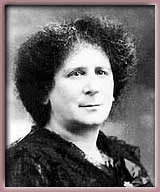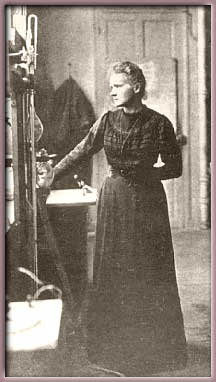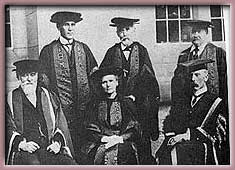She
gave credit, however, to Rutherford and other scientists for their
contributions in explaining radioactive phenomena. Aware of accusations
that she had sullied Pierre's name, she acknowledged the role their
joint efforts had played in her work.
“...for her services in the advancement
of chemistry by the discovery of the elements radium and
polonium, by the isolation of radium and the study of the
nature and compounds of this remarkable element.”
--1911 Nobel Citation
|
|
 |
|
Hertha Ayrton, in whose company Curie recuperated
during the summer of 1912, had first met the Curies in June
1903, when Pierre addressed the Royal Institution in London. (courtesy IEE) |
|
The stress
of the past several months took its toll on Curie. Suffering from
severe depression and acute kidney problems, she spent most of January
1912 in a private clinic, registered under an assumed name. In March
she underwent a kidney operation. She spent months recuperating in
a house near Paris, rented under the name Madame Sklodowska. Feeling
unworthy of Pierre's name, she even forbade Irène to address letters
to her as Madame Curie.
 LUDING
THE PRESS remained her highest priority. In late July, still using
the name Sklodowska, she traveled to England, where she spent the
rest of the summer with her friend and colleague Hertha Ayrton. Like
Curie, Ayrton was not only the widow of a distinguished physicist
but also an important practicing physicist herself. The two women
were joined in their rented house near the seashore by Curie's daughters
and their Polish governess. LUDING
THE PRESS remained her highest priority. In late July, still using
the name Sklodowska, she traveled to England, where she spent the
rest of the summer with her friend and colleague Hertha Ayrton. Like
Curie, Ayrton was not only the widow of a distinguished physicist
but also an important practicing physicist herself. The two women
were joined in their rented house near the seashore by Curie's daughters
and their Polish governess. |
|
In October 1912 Curie
returned to France but not to Sceaux, where the angry mob had once
threatened her and her children. After further bed rest in the Paris
apartment where she would live the rest of her life, she felt well
enough to return to the lab. On December 3, 1912, she made her first
lab notebook entry in nearly 14 months. The scandal had finally
blown over: Madame Langevin had not mentioned Madame Curie by name
in the separation agreement. The French academic world was ready
to welcome the world's only double Nobel laureate.
“I
have been led to think that there is a public service to be organized,
which I cannot ignore, and that it could not have been properly
established without myself and my laboratory's participation.”
--Marie Curie to the dean of the Sorbonne, May, 1913
|
 |
| Curie in her laboratory
in 1913, following the Langevin scandal. (Photo ACJC) |
|
 |
|
When Curie traveled to England in September
1913 to receive an honorary degree from the University of Birmingham,
she traveled again under her married name. |
|
 O
MORE LOVE AFFAIRS
lay in Curie's future. Though there would be no union between Marie
Curie and Paul Langevin, her granddaughter Hélène and his grandson
Michel would eventually marry. Marie Curie dedicated most of the rest
of her life to the Radium Institute, which she considered both a tribute
to Pierre's memory and a contribution to the betterment of human society. O
MORE LOVE AFFAIRS
lay in Curie's future. Though there would be no union between Marie
Curie and Paul Langevin, her granddaughter Hélène and his grandson
Michel would eventually marry. Marie Curie dedicated most of the rest
of her life to the Radium Institute, which she considered both a tribute
to Pierre's memory and a contribution to the betterment of human society.
Here scientists and technicians would monitor the purity and efficacy
of radioactive products for medicine and industry, while conducting
research to produce both pure knowledge and further beneficial uses.
After long labors of design and construction, Curie saw her building
completed on a street in the Latin Quarter, newly named Rue Pierre-Curie.
It was August 1914. |
|

